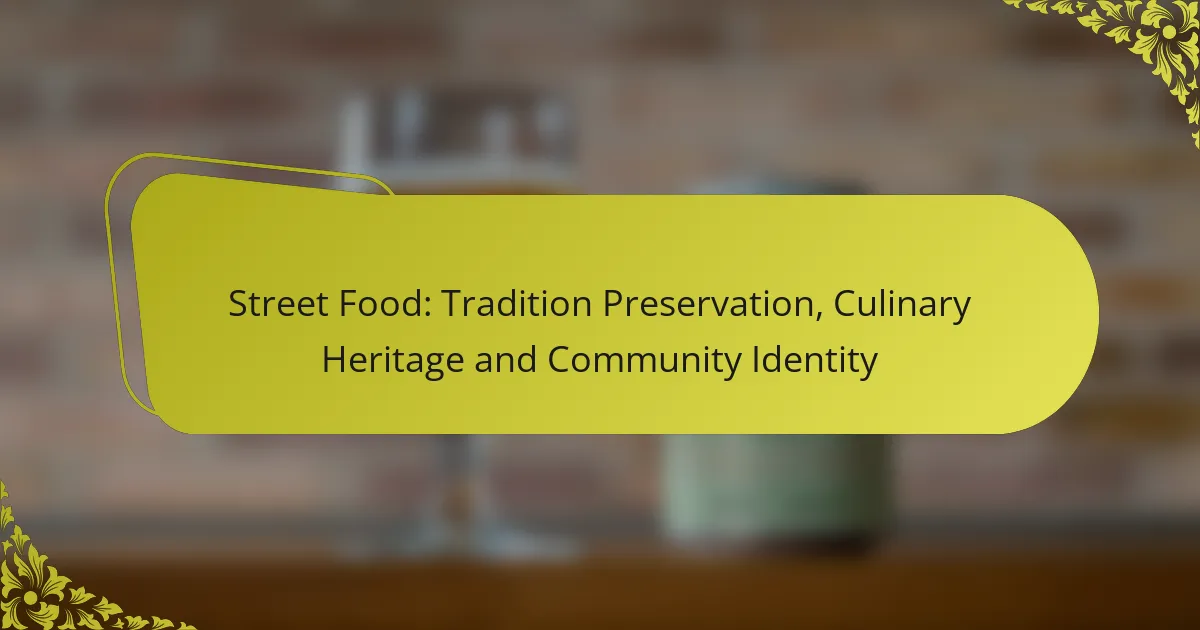Street food is an essential component of culinary heritage, preserving traditional cooking methods and recipes that embody a community’s culture. It not only serves as a living archive of local flavors but also shapes community identity by fostering social interactions and cultural exchange among residents.

How Does Street Food Preserve Culinary Heritage?
Street food plays a vital role in preserving culinary heritage by maintaining traditional cooking methods and recipes that reflect a community’s culture. It serves as a living archive of local flavors and practices, ensuring that these culinary traditions are passed down through generations.
Connection to traditional recipes
Street food vendors often rely on age-old recipes that have been handed down within families or communities. These recipes typically feature unique cooking techniques and flavor profiles that are emblematic of the region. For example, in Thailand, street food like Pad Thai showcases the balance of sweet, sour, and salty flavors that define Thai cuisine.
By sticking to these traditional recipes, street food not only satisfies local palates but also educates newcomers about the cultural significance of these dishes. This connection fosters a sense of pride among community members who see their heritage reflected in the food they consume.
Use of local ingredients
Street food often emphasizes the use of local ingredients, which supports regional agriculture and promotes sustainability. Vendors typically source their products from nearby markets or farms, ensuring freshness and quality. For instance, in Mexico, street tacos are made with locally sourced corn tortillas and regional meats, highlighting the area’s agricultural bounty.
Utilizing local ingredients not only enhances the flavor of the dishes but also strengthens community ties. It encourages consumers to appreciate and support local farmers and producers, thereby reinforcing the local economy and culinary identity.
Community involvement in preparation
Community involvement in street food preparation is crucial for preserving culinary heritage. Many street food vendors are family-run businesses where recipes and cooking techniques are taught through hands-on experience. This practice not only keeps traditions alive but also fosters a sense of belonging and shared identity among community members.
Additionally, street food festivals and markets often feature cooking demonstrations and workshops, allowing locals to engage with their culinary heritage actively. These events provide opportunities for knowledge exchange and help younger generations learn the importance of their cultural food practices.

What Role Does Street Food Play in Community Identity?
Street food plays a crucial role in shaping community identity by reflecting local traditions, flavors, and social interactions. It serves as a medium for cultural exchange and fosters a sense of belonging among residents.
Social gatherings and events
Street food often acts as a focal point for social gatherings and community events, bringing people together in shared experiences. Festivals, markets, and food fairs frequently feature local vendors, creating an atmosphere of celebration and camaraderie.
These events not only promote local cuisine but also encourage interactions among diverse groups, strengthening community ties. For instance, food trucks at a local fair can attract families, friends, and tourists, enhancing the sense of community.
Representation of cultural diversity
Street food is a vibrant representation of cultural diversity, showcasing the culinary heritage of various ethnic groups within a community. Each vendor often brings unique recipes and cooking styles that reflect their background, contributing to a rich tapestry of flavors.
This diversity allows residents and visitors to experience different cultures through food, fostering appreciation and understanding. For example, a neighborhood might feature stalls offering Mexican tacos, Indian samosas, and Vietnamese pho, highlighting the multicultural fabric of the area.
Local pride and identity
Street food cultivates local pride and identity by celebrating regional specialties and traditional cooking methods. Many communities take pride in their unique street food offerings, which can become a symbol of local culture.
Residents often support local vendors as a way to promote their community, leading to a sense of ownership and connection. For instance, a city known for its famous hot dog stands may host competitions or events to honor this culinary tradition, reinforcing local identity.

How Can E-Commerce Support Street Food Vendors?
E-commerce can significantly enhance the visibility and sales of street food vendors by providing online platforms for ordering, marketing, and delivery services. By leveraging digital tools, vendors can reach a broader audience and streamline their operations.
Online platforms for ordering
Online ordering platforms allow street food vendors to set up virtual storefronts where customers can browse menus and place orders. Popular platforms like Uber Eats, Grubhub, and local equivalents enable vendors to expand their customer base beyond foot traffic.
To maximize effectiveness, vendors should ensure their menus are clear and visually appealing, including high-quality images and concise descriptions. Offering promotions or discounts for first-time online orders can also encourage new customers to try their food.
Marketing local street food
Effective marketing strategies for street food vendors include utilizing social media, local food blogs, and community events. Platforms like Instagram and Facebook are ideal for sharing enticing photos and engaging with customers directly.
Vendors should consider collaborating with local influencers or participating in food festivals to increase their visibility. Regularly updating their online presence with new menu items or seasonal offerings can keep customers interested and returning for more.
Delivery services for street food
Delivery services are crucial for street food vendors looking to reach customers who prefer dining at home. Many vendors partner with established delivery services to ensure timely and efficient order fulfillment.
When choosing a delivery partner, vendors should evaluate factors such as delivery fees, service areas, and customer reviews. Offering a reliable delivery option can enhance customer satisfaction and encourage repeat business, especially in urban areas where convenience is key.

What Are the Challenges Facing Street Food Vendors?
Street food vendors face several significant challenges that can impact their operations and success. These include navigating regulatory hurdles, adhering to health and safety standards, and competing with established restaurants.
Regulatory hurdles
Street food vendors often encounter complex regulations that vary by location. These can include licensing requirements, zoning laws, and restrictions on where food can be sold. Understanding and complying with these regulations is crucial for vendors to operate legally and avoid fines.
In many cities, obtaining the necessary permits can be time-consuming and costly, sometimes taking weeks or even months. Vendors should research local regulations and consider seeking assistance from local business associations to streamline the process.
Health and safety standards
Health and safety standards are critical for street food vendors to ensure food quality and customer safety. Vendors must comply with local health codes, which often dictate food handling practices, sanitation requirements, and equipment standards.
Regular training on food safety practices is essential for vendors and their staff. This can include understanding proper food storage temperatures, avoiding cross-contamination, and maintaining cleanliness in food preparation areas. Failure to comply with these standards can lead to health violations and loss of business.
Competition from restaurants
Street food vendors face stiff competition from established restaurants that often have more resources and marketing power. Restaurants may offer a wider variety of menu items, more comfortable dining environments, and established customer bases.
To stand out, street food vendors should focus on unique offerings, quality ingredients, and exceptional customer service. Building a strong brand presence through social media and community engagement can also help attract loyal customers and differentiate from traditional dining options.

How Can Street Food Enhance Urban Tourism?
Street food can significantly enhance urban tourism by attracting visitors who seek authentic culinary experiences. It serves as a gateway to local culture, allowing tourists to engage with the community and its traditions through food.
Attracting food enthusiasts
Street food markets and stalls often draw food enthusiasts eager to explore diverse flavors and unique dishes. Cities known for their vibrant street food scenes, such as Bangkok or Mexico City, can see a notable increase in tourist foot traffic, especially during food festivals or culinary tours.
To capitalize on this, cities can promote local food events and create food trails that guide tourists to popular street vendors. Engaging social media campaigns can also help showcase the variety and quality of street food offerings, enticing more visitors.
Showcasing local culture
Street food is a reflection of a city’s cultural heritage, showcasing traditional recipes and cooking methods passed down through generations. Vendors often incorporate local ingredients and flavors, providing tourists with a taste of the region’s identity.
For example, in Italy, street food like arancini or supplì highlights local rice varieties and regional sauces. Cities can enhance this cultural experience by organizing food tours that explain the history and significance of each dish, fostering a deeper appreciation among tourists.
Creating unique experiences
Street food offers tourists the chance to enjoy meals in informal settings, often with vibrant atmospheres that reflect the local community. Eating at food stalls or markets allows visitors to interact with locals, creating memorable experiences that traditional restaurants may not provide.
To enhance these unique experiences, cities can host cooking demonstrations or workshops where tourists can learn to prepare local dishes. Encouraging street food vendors to share their stories and culinary techniques can further enrich the tourist experience, making it both enjoyable and educational.

What Are the Economic Benefits of Street Food?
Street food contributes significantly to local economies by creating jobs, boosting small businesses, and enhancing community engagement. These benefits not only support individual livelihoods but also foster a vibrant local culture and economy.
Job creation in local communities
Street food vendors often employ local residents, providing essential job opportunities in areas with limited employment options. These positions can range from cooking and serving to managing operations, creating a diverse workforce.
In many cities, street food markets can employ dozens of individuals, from chefs to support staff, thus reducing local unemployment rates. This job creation is particularly vital in urban areas where traditional employment may be scarce.
Boosting local economies
Street food stimulates local economies by attracting both residents and tourists, leading to increased foot traffic and sales for nearby businesses. When people visit street food vendors, they often spend money on other local services, such as shops and entertainment.
Moreover, street food can generate significant tax revenue for municipalities, which can be reinvested into community services. This cycle of spending helps to sustain and grow the local economy, benefiting everyone involved.
Supporting small businesses
Street food vendors often start as small businesses, allowing entrepreneurs to enter the market with lower overhead costs compared to traditional restaurants. This accessibility encourages innovation and diversity in food offerings, enriching the culinary landscape.
By supporting street food, communities can help these small businesses thrive, which in turn fosters a sense of identity and pride. Local regulations often favor these vendors, providing them with opportunities to operate in public spaces and participate in community events.
